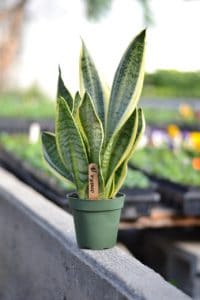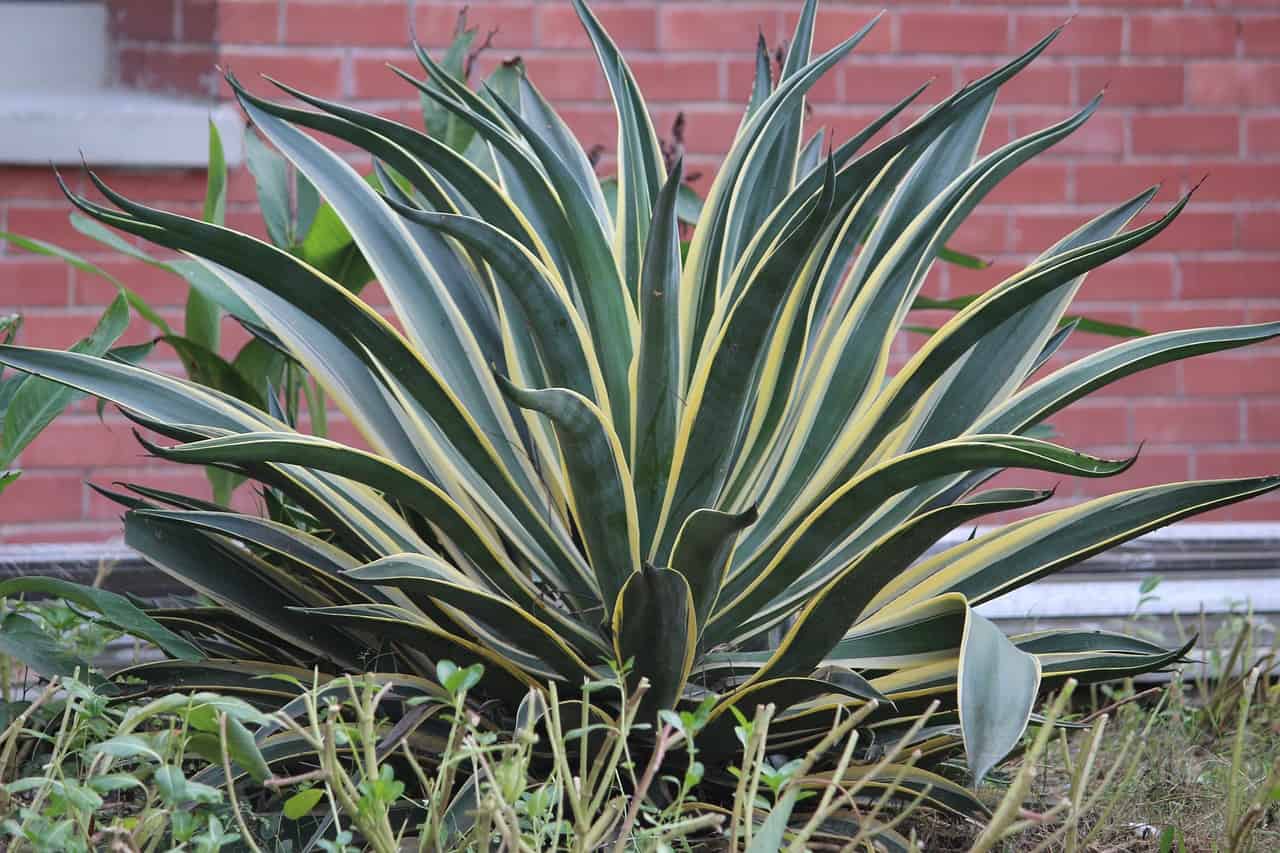Some links in the post are affiliate links and I get a commission from purchases made through some links found in the post.
Welcome to why your snake plant has no roots. They say every day’s a school day and I certainly found this out recently!
I have several plants around my house and out on the front patio that I have always called Mother-in-law’s tongue.
I even know that they are also called Sansevieria. What I did not know is that the other name they go by is Snake Plant!
Now that I have established the third name for my plants, I can start to talk about them. I love them!
They are no bother at all, even if I forget to water them. They seem to grow well indoors and outdoors and are possibly one plant that is truly classed as low maintenance.
I see these plants all over our village, on windowsills or outside in large pots. They are immensely popular and for good reasons.
The question you’re asking is why does your snake plant have no roots? The snake plant will have no roots due to overwatering or a fungus infection which will have destroyed the roots.
The only way to get the roots back is the propagate a healthy part of the snake plant and grow a new snake plant in fresh soil being sure to follow good care practices.
Snake Plants:
- Are low maintenance
- Can grow in most light conditions
- Are long lasting
- React very slowly to mistreatment
- Are really easy to propagate
- Are inexpensive
How to Care for Your Snake Plant?
Your Snake Plant is classed as an evergreen plant. The genus is Sansevieria (we knew that didn’t we?) and it is a hardy member of this group.
The Snake Plant will do well and flourish in cool climates indoors as well as in hot climates and housed outdoors. That is the reason for its popularity.
Space
While most plants need extra space for their roots, the Snake Plant prefers being pot-bound and having all its roots tangled.
Never be in a hurry to repot the plant as it will be quite happy being cramped. In fact, it will do well in this condition.
When you feel that it is becoming seriously overcrowded you can go ahead and repot into a slightly larger pot.
Because Snake Plants do not tolerate standing water, you need to make sure that the soil you use drains well.
Sunlight
Snake Plants do well on sunny windowsills and in direct light. In fact, the more sunlight, the better the plant will grow.
If you are in a cooler climate you should place your Snake Plant in a north-facing window or somewhere similar so that it gets as much sunshine as possible.
Snake Plants do not like cold and frost and should be brought inside in these conditions.
If you live in an area where you do get frost then do not be tempted to just cover the Snake Plant as it will not survive. You need to bring it indoors until the frost season is past.
Outdoors – your plant will thrive anywhere where the is plenty of light. If you live in an extremely hot place, then your plant will benefit from some shade in the hottest part of the day.
The ideal temperatures for a Snake Plant are between 60 – 80°F. If the leaves of your plant start to turn yellow, it is an indication that they are feeling a little too cold for comfort and need to be brought inside.
Cleaning
It is a good idea to keep the leaves clean and dust free. To do this you should use a soft, damp cloth and gently wipe the leaves so that they are shiny and green again.
You may also like: how big can a snake plant get
Bringing a new Snake Plant Home

If you are buying your new plant from a nursery, then make sure you choose the most vigorous looking plant.
Look for one with deep green leaves which are upright and firm.
Any light or pale leaves show that the plant is not healthy or has been badly treated. While you may get the plant to recover, it will take a lot of time and attention.
If you are given a cutting from your neighbor, then you should also try and get the deepest green color you can.
These cuttings will propagate far easier than an unhealthy cutting, which may even die.
A Little About Their Root System
These plants have very shallow roots which are called rhizomes. It is here that you will be able to see the health of your Snake Plant. This will also indicate what sort of care your plant needs.
If your Snake Plant is grown in a pot that is about 24” deep, you will find that the roots go down less than half the distance, so they are not a deep rooting plant.
The rhizomes, or roots spread out to the sides of the plant, instead of down.
If we relate this to how we water our Snake Plant you will see that standing the plant in a base of water will not be effective as the roots are simply not deep enough to benefit from it.
In fact, standing in water may in fact be detrimental for your Snake Plant. The water may become stagnant and start to smell badly.
Your Snake Plant does not enjoy being too wet or too dry, although it will do better if it is dry rather than waterlogged.
One thing about watering the Snake Plant is that it prefers consistency. Be consistent in watering the entire surface evenly.
Be consistent in how often you water the plant, and be consistent in the soil condition, neither too wet nor too dry.
Why do Some Snake Plants Have no Roots?
So, taking a closer look at the Snake Plant you may notice that there do not even seem to be roots. We know that plants need a root system in order to survive. How then does the Snake Plant get by?
If you see that the plant has no roots it may be a sign of a diseased plant. The lack of roots is caused mainly by too much water.
Another reason for the lack of roots is a fungus which they are susceptible to and has damaged the roots below the soil line. This could be any one of several species such as Rhizoctonia or Pythium.
One thing I have learned about these plants and the lack of roots is not to give up on them and throw them away.
You can take a cutting and regrow another plant, even though you may think that all is lost. We’ll talk more about propagation in a bit.
As we know, our Snake Plant should normally have its leaves standing up straight and tall. This is a good indication of a healthy plant.
Occasionally the leaves will grow out to the sides but generally they are upright.
A Snake Plant with leaves flopping of to the sides may be ill. Checking the roots will simply confirm this for you – there may be none!
The main reason for your plant having no roots is down to overwatering – it’s as simple as that. The roots have rotted away, and the leaves begin to sag.
An easy test to see the health of your Snake Plant is to check the leaves. If they are loose when you touch them and can be pulled out of the ground, your plant is most likely ill.
If you are enjoying this article, check out our article on how to save your snake plant from root rot.
Why are the Roots Above the Soil?
Every so often I have noticed that one of my plants seems to have roots growing above the soil. The fact of the matter here is that this does happen occasionally, even in a healthy plant.
One of the reasons for roots to appear on the top of the soil may be because there is an unequal absorption of water and the roots are heading off to find more, hence you see them.
Clay pots can also absorb the water which is meant for your plant so a different type of pot may improve things.
Soil which does not drain well may also be the reason for the roots heading upwards. You may want to change to a soil which is suitable for tropical houseplants.
Can we Save the Snake Plant and Solve Root Health Issues?
 Unfortunately, if the snake plant roots have rotted away you cannot save the entire plant. If your snake plant has root rot it means that the roots have died from lack of oxygen.
Unfortunately, if the snake plant roots have rotted away you cannot save the entire plant. If your snake plant has root rot it means that the roots have died from lack of oxygen.
What you can do is to take whatever leaves you can and grow some more plants.
To me, this is a great option because you get several more plants from just one – free plants, not to mention the kick you get out of seeing the new plants grow.
To solve root rot issues, you simply need to be aware that overwatering will kill your plants.
Don’t be tempted to have your Snake Plants on the same watering regime as your other house plant, it just doesn’t work.
When in doubt, leave the plant alone, rather than water it. If the plant is not too far gone, simply leaving it without water for a few days may help it to recover. This should be your first option.
Trying to Treat the Plant
If you plan on trying to save the existing plant, you should stop watering it for a few days and place in a sunny position.
- Remove the plant from the pot and change the soil. Preferably use a new pot.
- Cut away any infected roots if there are any left. Make sure you use clean scissors.
- Treat any remaining roots with a fungicide.
- Repot using fresh soil which has good drainage properties.
How to Propagate Your Snake Plant?
Here’s the part I really like – growing more plants! Not only is this rewarding, but it also ensures you have a steady supply of plants for your garden and to give to friends.
It is quite easy to propagate Snake Plants by using the existing leaves.
- Remove any parts that are damaged
- Treat with a fungicide. I like to use cinnamon because it is natural, and it seems to work very well. Just take dry cinnamon and rub on the areas where you have made cuts. Leave the pieces for 24 hours.
- Have a potting mix ready, make sure it has good drainage.
- Stand the leaves upright in the pot and fill around with the new potting mix.
- Give a small amount of water just to bed the new leaves in, then leave alone.
Be patient now! If possible, place the cuttings in a well-lit area and only water when the soil is dry.
Within four to six weeks you should have a well-established healthy plant. You will know that it is healthy if you gently pull at the leaves and they resist.
It is true that propagating this way does not always work. It is not because of anything you have done, it is simply because the cutting did not take root.
If you prefer you can make your own potting mix. This way you know exactly what goes into it.
Ideally you should use three parts of potting soil, two parts of sand (builders sand works well here) and one part of pumice. Mix well and keep in a dry place.
Other Snake Plant Health Issues and What to Look Out for?
Fungal Disease
This is the most common issue with Snake Plants. This mainly happens because of excess moisture in and around the plant.
Fungal diseases can include Southern Blight and Red Leak Spot. Both these you will recognize by the red/brown sunken lesions on the leaves.
Smelly Leaves
Too much water or a waterlogged plant pot will cause the leaves to start to smell. They give off a particularly horrible smell, which is not what you want in either your home or the office.
Remove the leaves which are affected and place the pot in a sunny place to absorb excess water.
Brown Leaves
After talking so much about watering too much, you may be surprised to hear that you can underwater your Snake Plant.
A sure sign of lack of water is brown leaves. They may also seem to be ‘crunchy.’ You should remove the affected leaves and give your plant a drink.
Leaf Tips which are Brown
This is an indication of inconsistent watering, either too much or too little. Leave the tips alone, check your watering schedule and let your plant recover by itself.
You should check the soil conditions and make a note when you water the plant that the water does indeed soak in consistently.
If one area drains away much faster than another, you may see the roots reaching out of the soil.
Scars
Your Snake Plant does not like to be handled too much. Neither does it appreciate being brushed against.
If it is in a position where it gets knocked and touched you may want to move it elsewhere to a place where it will be happy. Any touching and rough handling will leave a scar.
Benefits of Having a Snake Plant
Not only does this plant look good there are also some proven health benefits to it. Your innocent looking Snake Plant plays a vital role in removing toxins from the air.
Removal of Toxins
The air we breathe also contains some really nasty elements such as trichloroethylene, formaldehyde, benzene, and xylene, to name a few. Once inhaled these can be lethal to our bodies.
The Snake Plant has a built-in filtering system which removes harmful toxins from the air.
Inexpensive as a Decoration
These plants are among the least expensive to buy. Of course, if you propagate them yourself, they are even cheaper!
Strategically placed, they add to the décor of any space, even sophisticated offices. Indeed, they help to maintain feng shui.
If you are unsure as to what that means, it is simply that these plants help to create a balance in living spaces.
Reduce Airborne Allergies
Because they help to remove toxins, the plants also aid and work as a good defense against airborne allergies.
Final Thoughts: Why your Snake Plant has no roots?
 Snake Plants, also known as Mother-in-Law’s Tongue, are members of the succulent family. They are very resilient and can grow up to several feet in height in the perfect conditions.
Snake Plants, also known as Mother-in-Law’s Tongue, are members of the succulent family. They are very resilient and can grow up to several feet in height in the perfect conditions.
They are beautiful evergreen plants which apart from looking great, can also keep the air cleaner in your home.
By removing and absorbing nasty things such as nitrogen oxides and formaldehyde you may even notice that your allergies are vastly reduced with some of these around your home.
Apart from using them in the home, the plants look great in offices as they do not drop leaves, spread out to far or encroach on other areas. They can simply be placed in a spot and left to look good.
Snake Plants need minimal maintenance, which makes them perfect for people who are not ‘green fingered.’
They are also ideal companions if you leave your home for any length of time. They do well with less water than any other houseplants.
So, while the Snake Plant has a well-deserved reputation as being a hardy plant, it still needs some maintenance.
It will be slower to respond to mistreatment, but it will eventually become an unhealthy plant.
Leaves which contain too much water will become mushy and then droop over to the side and the roots will rot, causing the plant to die.
The good thing about Snake Plants is that they are easy to propagate and grow in most conditions, either inside or outside.
With just a little care and attention you can have as many of these attractive plants in and around your home.
Before you go, here are some more related articles I encourage you to read below to help solve more of your gardening issues:
4 Tips to Care for a Snake Plant in the Winter
What is a scindapsus treubii dark form
Top 10 Best Indoor Floor Plants & Considerations When Buying
Best 10 House Plants for Aquaponics
Written by: Valerie Holyoak



